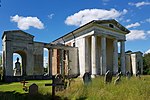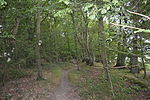Ayot Park
Buildings and structures in Ayot St LawrenceCountry houses in HertfordshireGrade II* listed buildings in HertfordshireGrade II listed parks and gardens in HertfordshireUnited Kingdom listed building stubs
Ayot Park is a grade II listed park and garden at Ayot St Lawrence in Hertfordshire, England. It contains the grade II* listed Ayot House along with an earlier manor house and a walled kitchen garden which are also listed. The estate was acquired in 1723 by Cornelius Lyde and after his death it passed to Sir Lionel Lyde who was both his nephew and son-in-law. Sir Lionel built the grade I listed St Lawrence Church which faces the house across the park. It was consecrated in 1779.
Excerpt from the Wikipedia article Ayot Park (License: CC BY-SA 3.0, Authors).Ayot Park
Hill Farm Lane, Welwyn Hatfield Ayot St Lawrence
Geographical coordinates (GPS) Address Nearby Places Show on map
Geographical coordinates (GPS)
| Latitude | Longitude |
|---|---|
| N 51.84 ° | E -0.265 ° |
Address
Hill Farm Lane
AL6 9BU Welwyn Hatfield, Ayot St Lawrence
England, United Kingdom
Open on Google Maps









